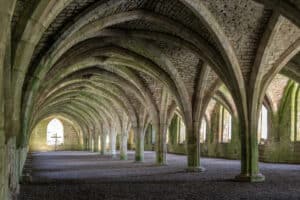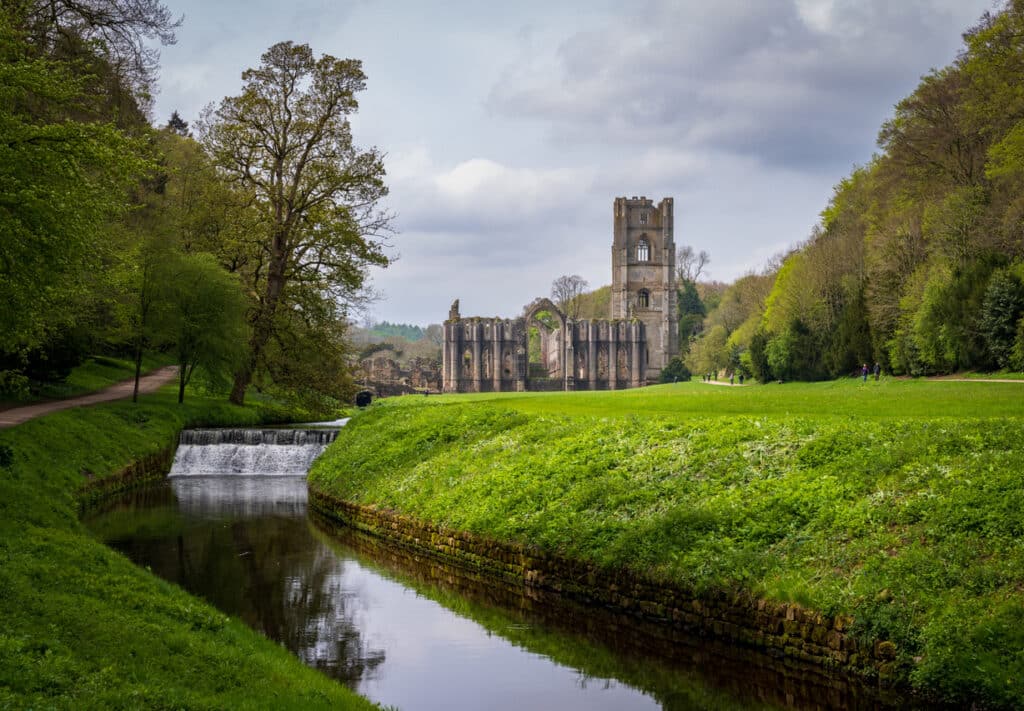Nestled amidst the tranquil Yorkshire countryside, just a stone’s throw from the historic city of Ripon, lies Fountains Abbey – a UNESCO World Heritage Site that effortlessly blends awe-inspiring monastic ruins with the serene beauty of a Georgian water garden. More than just a collection of ancient stones, Fountains Abbey and Studley Royal Water Garden offer an immersive journey through centuries of history, architectural brilliance, and natural artistry, making it an indispensable stop for any discerning traveller.
The story of Fountains Abbey begins in 1132, when thirteen Benedictine monks from St. Mary’s Abbey in York, seeking a purer, more austere form of monastic life, established a new community in the valley of the River Skell. These were Cistercian monks, an order renowned for their commitment to hard work, self-sufficiency, and simple living. The early years were challenging, marked by privation and dedication, but the abbey soon flourished, growing into one of the wealthiest and most influential Cistercian monasteries in England.
As you approach the abbey ruins today, the sheer scale and grandeur are immediately apparent. The vast remains of the church, stretching over 300 feet in length, dominate the landscape. Here, you can wander through the nave, tracing the path where countless monks once walked, their chants echoing through the vaulted ceilings. The transepts, with their soaring arches, and the chapter house, where daily business was conducted, offer a palpable sense of the monastic routine. Imagine the abbey at its zenith, a bustling community of monks and lay brothers, their lives dictated by prayer, labour, and study. The cloisters, the heart of the monastic complex, provide a peaceful space for contemplation, their arcades framing views of the central garth.
One of the most striking features of Fountains Abbey is the remarkably preserved cellarium, a vast, vaulted undercroft used for storing provisions. Its immense size and sturdy construction are a testament to the engineering prowess of the mediaeval builders. Equally impressive are the remains of the infirmary, where sick monks were cared for, and the guest house, reflecting the abbey’s tradition of hospitality. The sheer completeness of the ruins allows visitors to truly grasp the layout and function of a mediaeval monastery, offering a rare insight into a way of life long past.

However, the story of Fountains Abbey does not end with its dissolution in 1539 during Henry VIII’s reign. After centuries of monastic life, the estate passed into private hands, eventually coming into the possession of the Aislabie family in the 18th century. It was John Aislabie, and later his son William, who embarked on the ambitious project of creating Studley Royal Water Garden, transforming the monastic landscape into a masterpiece of Georgian design.
The transition from the austere beauty of the abbey to the refined elegance of the water garden is remarkably seamless. As you stroll through the meticulously manicured lawns and woodland, you’ll encounter a series of exquisite follies, classical temples, and statues that perfectly complement the natural surroundings. The Moon Pond, with its crescent shape reflecting the sky, and the Octagon Tower, offering panoramic views, are just a few of the delightful surprises that await. The whole design is a testament to the principles of the English landscape garden, where nature is enhanced and framed to create a picturesque and harmonious vista.
The crowning glory of Studley Royal is undoubtedly the dramatic canal, designed to create a visual link between the formal garden and the ancient abbey. As you walk alongside its tranquil waters, with the imposing ruins gradually coming into view, you experience a truly breathtaking moment where two distinct historical periods coalesce into a single, magnificent tableau. It’s this unique juxtaposition – the solemnity of the mediaeval ruins against the playful elegance of the Georgian garden – that elevates Fountains Abbey and Studley Royal to an unparalleled status.
Beyond the historical and architectural wonders, Fountains Abbey is also a haven for nature lovers. The estate boasts a rich diversity of flora and fauna, and the tranquil riverside walks offer a chance to spot kingfishers, otters, and a variety of birdlife. The ancient deer park, home to red, fallow, and sika deer, provides a wilder counterpoint to the cultivated gardens and is a joy to explore, particularly during the rutting season when the stags’ calls echo through the trees.
For those seeking sustenance, the visitor centre offers a café serving delicious local produce, while the gift shop provides an opportunity to pick up souvenirs and books on the abbey’s fascinating history. The National Trust, which cares for Fountains Abbey, has ensured excellent accessibility, with well-maintained paths and facilities catering to all visitors.
In conclusion, Fountains Abbey and Studley Royal Water Garden are far more than just a historical site; they are an experience. They are a place where the echoes of monastic life mingle with the whispers of Georgian elegance, where architectural ambition meets natural beauty. Whether you’re a history buff, a garden enthusiast, a nature lover, or simply seeking a tranquil escape from the everyday, Fountains Abbey offers a journey of discovery and contemplation that will linger in your memory long after you’ve left its hallowed grounds. It is a true jewel in the crown of Yorkshire, awaiting your exploration.

